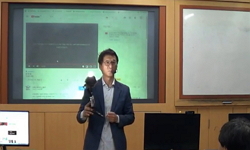이 연구는 지명을 텍스트 밖의 언어로 이해하면서, 당대(當代) 언중(言衆)의 지명 인식과 장소에 관한 이야기를 매체(媒體)를 통한 지명 관련 표현으로 읽어내고자 한다. 다시 말해, 지리적 ...
http://chineseinput.net/에서 pinyin(병음)방식으로 중국어를 변환할 수 있습니다.
변환된 중국어를 복사하여 사용하시면 됩니다.
- 中文 을 입력하시려면 zhongwen을 입력하시고 space를누르시면됩니다.
- 北京 을 입력하시려면 beijing을 입력하시고 space를 누르시면 됩니다.

매체를 통해 본 지명의 상징성과 사회적 의미 - 지명 관련 표현을 중심으로 = The Reality of Symbolism and Social Semantic through Media - Focusing on Expressions Related to Place Names
한글로보기부가정보
국문 초록 (Abstract)
언어는 시대를 살아가는 언중의 의식을 반영하고, 사회 언중의 의식은 대상에 대한 언어로 나타난다. 이를 근거로 한다면, 사회에서 사용되는 지명 관련 표현들은 그 지역에 대한 당대 언중의 장소 인식을 반영한다고 볼 수 있다. 다시 말해, 그 시대 매체의 텍스트에서 나타나는 지명 관련 어휘는 언중들이 인식하고 있는 지역의 정체성에 대한 이해를 반영한 하나의 기호가 된다는 것이다.
실제 지명을 사용하여 공포영화를 만들었을 때, 지명에 연상되는 장소의 이미지가 부정적으로 인식되는 경우가 있다. 또한 나쁜 사건이나 사고, 안 좋은 이미지 등과 연관되어 사용되는 사건 관련 지명은 지역이 지니는 가치가 손상되고 나아가 그 지역에 대한 회피(回避)로 이어질 수 있다.
매체에서 나타나는 지명 관련 표현은 특정한 사회적 상황 속에서의 새로운 관점이 될 수 있다. 그러하기에 지명과 관련된 신어(新語)의 출현과 지역 정체성과의 관계, 기존 지명에 대한 개념 변화를 당대의 매체 텍스트를 통해 살펴보는 것은 지명의 현대적 가치를 이해하는 과정이 될 수 있다.
이 연구는 매체 속에서의 지명 관련 표현을 중심으로 지역의 특성을 살폈다. 따라서 기존의 지명에 대한 연구들과는 다른 층위에서 지명이 사회 속에서 가지는 의미를 찾는 과정이었다고 할 수 있다. 매체의 텍스트를 자료로 한 것은 현대사회에서 매체가 언중들의 인식형성에 밀접한 관련이 있기 때문이다. 장소의 명명(命名)으로서, ‘지명’이 상징하는 기표(旗標)는 지명과 관련된 신조어로 확인할 수 있었다.
이 연구는 지명을 텍스트 밖의 언어로 이해하면서, 당대(當代) 언중(言衆)의 지명 인식과 장소에 관한 이야기를 매체(媒體)를 통한 지명 관련 표현으로 읽어내고자 한다. 다시 말해, 지리적 위치를 나타내는 이름으로서의 지명이 매체에서 어떻게 사용되며 사회적 의미를 형성하는지를 고찰하는 것이다. 이를 위해 본 연구는 퍼스의 기호학(記號學)을 적용하여 지명이 지니게 되는 의미와 지역의 정체성(正體性)을 탐색해 가고자 한다.
언어는 시대를 살아가는 언중의 의식을 반영하고, 사회 언중의 의식은 대상에 대한 언어로 나타난다. 이를 근거로 한다면, 사회에서 사용되는 지명 관련 표현들은 그 지역에 대한 당대 언중의 장소 인식을 반영한다고 볼 수 있다. 다시 말해, 그 시대 매체의 텍스트에서 나타나는 지명 관련 어휘는 언중들이 인식하고 있는 지역의 정체성에 대한 이해를 반영한 하나의 기호가 된다는 것이다.
실제 지명을 사용하여 공포영화를 만들었을 때, 지명에 연상되는 장소의 이미지가 부정적으로 인식되는 경우가 있다. 또한 나쁜 사건이나 사고, 안 좋은 이미지 등과 연관되어 사용되는 사건 관련 지명은 지역이 지니는 가치가 손상되고 나아가 그 지역에 대한 회피(回避)로 이어질 수 있다.
매체에서 나타나는 지명 관련 표현은 특정한 사회적 상황 속에서의 새로운 관점이 될 수 있다. 그러하기에 지명과 관련된 신어(新語)의 출현과 지역 정체성과의 관계, 기존 지명에 대한 개념 변화를 당대의 매체 텍스트를 통해 살펴보는 것은 지명의 현대적 가치를 이해하는 과정이 될 수 있다.
이 연구는 매체 속에서의 지명 관련 표현을 중심으로 지역의 특성을 살폈다. 따라서 기존의 지명에 대한 연구들과는 다른 층위에서 지명이 사회 속에서 가지는 의미를 찾는 과정이었다고 할 수 있다. 매체의 텍스트를 자료로 한 것은 현대사회에서 매체가 언중들의 인식형성에 밀접한 관련이 있기 때문이다. 장소의 명명(命名)으로서, ‘지명’이 상징하는 기표(旗標)는 지명과 관련된 신조어로 확인할 수 있었다.
다국어 초록 (Multilingual Abstract)
To achieve this, the study applies along with Peirce's semiotics, to explore the meanings embedded in place names and the regional identities they represent. Language reflects the consciousness of language users in a given era, and this consciousness manifests in the language used to describe objects. Based on this premise, expressions related to place names used in society can be seen as reflections of contemporary perceptions of those regions. Vocabulary related to place names appearing in media texts thus functions as signs that mirror language users' understanding of regional identity.
Understanding the social discourse on place names as presented in media within specific social contexts can provide new perspectives. Therefore, examining the emergence of neologisms related to place names, their relationship with regional identity, and the process of conceptual change regarding existing place names through contemporary media texts can reveal the modern value of place names.
When actual place names are used in horror films, the images associated with those locations may sometimes be perceived negatively. Moreover, when certain place names are linked to events, accidents, or unfavourable images, they can diminish the region's value, potentially leading audiences to avoid those areas altogether This study investigates regional characteristics by treating place names in media as units of vocabulary. Thus, it represents a process of uncovering the meanings of place names in society at a different level from previous studies on the subject. The use of media texts as data stems from the close relationship between media and the formation of language users' perceptions in modern society. The specific language representing the signifiers symbolised by "place names" as the naming of places could also be identified through neologisms.
This study aims to interpret place names as language beyond mere text, seeking to discern contemporary language users' perceptions of place names and locations through expressions related to place names found in media. In other words, it examines how ...
This study aims to interpret place names as language beyond mere text, seeking to discern contemporary language users' perceptions of place names and locations through expressions related to place names found in media. In other words, it examines how place names, as names representing geographical locations, are utilised in media and how they contribute to the formation of social meanings.
To achieve this, the study applies along with Peirce's semiotics, to explore the meanings embedded in place names and the regional identities they represent. Language reflects the consciousness of language users in a given era, and this consciousness manifests in the language used to describe objects. Based on this premise, expressions related to place names used in society can be seen as reflections of contemporary perceptions of those regions. Vocabulary related to place names appearing in media texts thus functions as signs that mirror language users' understanding of regional identity.
Understanding the social discourse on place names as presented in media within specific social contexts can provide new perspectives. Therefore, examining the emergence of neologisms related to place names, their relationship with regional identity, and the process of conceptual change regarding existing place names through contemporary media texts can reveal the modern value of place names.
When actual place names are used in horror films, the images associated with those locations may sometimes be perceived negatively. Moreover, when certain place names are linked to events, accidents, or unfavourable images, they can diminish the region's value, potentially leading audiences to avoid those areas altogether This study investigates regional characteristics by treating place names in media as units of vocabulary. Thus, it represents a process of uncovering the meanings of place names in society at a different level from previous studies on the subject. The use of media texts as data stems from the close relationship between media and the formation of language users' perceptions in modern society. The specific language representing the signifiers symbolised by "place names" as the naming of places could also be identified through neologisms.
동일학술지(권/호) 다른 논문
-
함경도 지명에 대하여 - 1930,40년대 『한글』에 실려 있는 지명자료를 중심으로
- 한국지명학회
- 김정태
- 2024
- KCI등재
-
자연의 지명화와 유산화 - 제주도 폭포의 차별적인 지명화와 명승화 과정
- 한국지명학회
- 김순배
- 2024
- KCI등재
-
전남 남해안 지역의 지명 고찰 - 『조선지지자료(朝鮮地志資料)』의 흥양군, 돌산군, 여수군 자료를 중심으로
- 한국지명학회
- 황금연
- 2024
- KCI등재
-
부천 향토지명의 발굴 및 조사 연구(下) - 인천과 부천의 접계지 ‘송내동’ · ‘상동’을 중심으로
- 한국지명학회
- 강재철
- 2024
- KCI등재




 KISS
KISS






